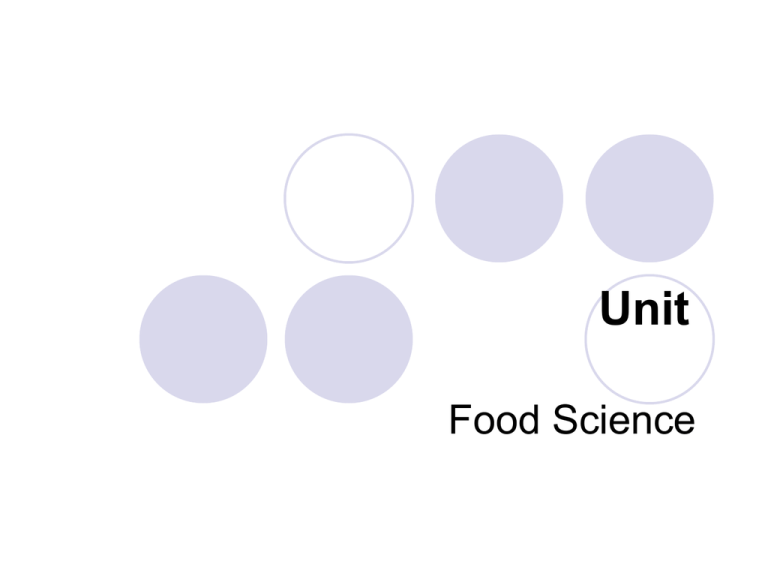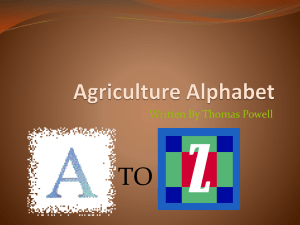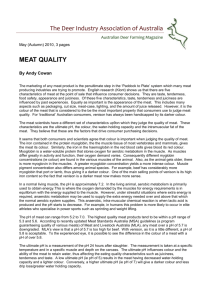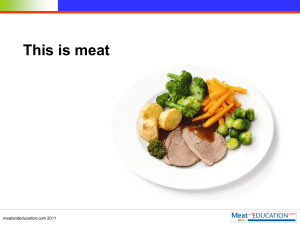Water Binding in Meat
advertisement

Unit Food Science Problem Area Processing Animal Products Lesson Water Binding in Meat Student Learning Objectives 1. Describe the importance of water to the characteristics of meat products. 2. Explain how postmortem changes affect water loss in meat and identify techniques applied directly after slaughter for reducing water loss in meat. 3. Explain the effects of non-meat additives on the water-binding ability of meat. Terms Actin Calcium phosphate Lactic acid Myosin pH Postmortem Rigor mortis What is the importance of water to the characteristics of meat products? Water contributes to many of the characteristics of meat products. A. Approximately 65% of the weight of fresh meat is from water which is directly related to the protein content of meat. There is a constant relationship of about 3.7 to 1 between water and protein content in fresh meat. B. In all living animals, water contributes to cellular integrity, meaning it provides the internal pressure to keep cells from collapsing on themselves. Water also provides lubrication for muscle fibers, allowing smooth contraction and release of muscle tissue. C. Protein binds with water in the cell because of a polar attraction between water and protein molecules. When an animal is slaughtered, the ability of the muscle to retain water is reduced. How do postmortem changes affect water loss in meat and what techniques are applied directly after slaughter for reducing water loss in meat? Postmortem changes will affect water loss in fresh meat. Several techniques are applied after slaughter to reduce water loss. A. Postmortem is a term used to describe the state of the animal after it has been slaughtered. Once an animal has been slaughtered, rigor mortis, or the stiffening of body joints due to contraction of the muscle tissue, begins after a few hours. Rigor mortis occurs in a dead body because of the body’s inability to keep calcium ions out of the muscle cells. Calcium ions promote the linking of actin and myosin, two types of muscle fibers, which begin to contract and are unable to release. The muscles will stay contracted until the muscle tissue begins to decompose, approximately 72 hours after death. Refrigeration and rapid cooling can delay the onset of rigor mortis, but the process will occur upon the thawing of the carcass. Meat is generally considered to be more tender if prepared after rigor mortis has passed. B. Most of the reduction in water holding capacity of muscle is due to a decrease in the pH of the muscle. pH is a measurement of the acidity or alkalinity of a substance. The final water-binding ability depends on the rate and extent of the pH drop. When the pH drops rapidly during the conversion of muscle to meat (slaughtering), a lower water-binding capacity results. C. The lowered pH is due to an accumulation of lactic acid, a product of glycogen metabolism, in the muscle of the animal. The lactic acid becomes concentrated in the muscle because the circulatory system, inactive after slaughtering, is unable to remove it. What effects do non-meat additives have on the water-binding ability of meat? A. The loss of water from the muscle after slaughter can be reduced by slowing down the production of lactic acid. Lactic acid production can be reduced by decreasing the temperature of the carcass and by using an additive to inhibit water loss. Salt and calcium phosphate are two common substances that are used as meat additives which promote water retention. Both of these cations (substances with a negative charge) increase the water-holding capacity of meat by neutralizing positively-charged ions that compete with water molecules for protein attachment. By neutralizing the competing ions, the water is allowed to bind with protein molecules, resulting in water retention and decreased water loss. Review/Summary What is the importance of water to the characteristics of meat products? How do postmortem changes affect water loss in meat and what techniques are applied directly after slaughter for reducing water loss in meat? What effects do non-meat additives have on the water-binding ability of meat?










